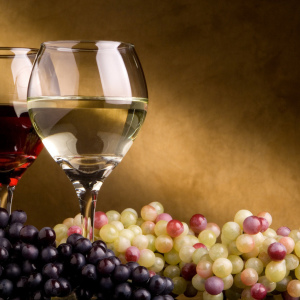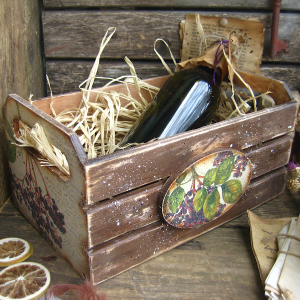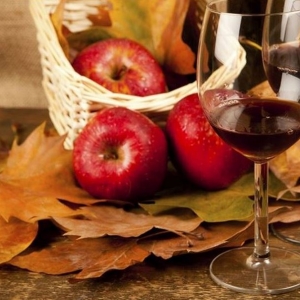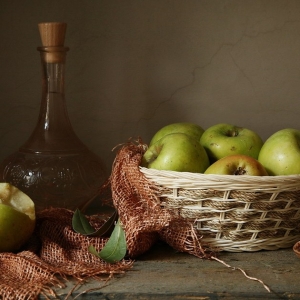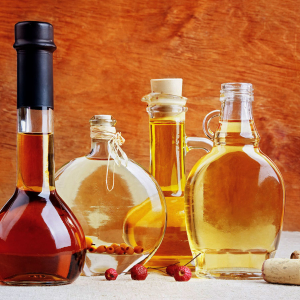Grapes Isabella - one of the most popular varieties that are actively grown in Russia. The bunches of grape vines have a dark blue color, with a fragrant odor and sour-sweet aftertaste. The famous Isabella nodes from South America, in the 17th century, the variety spread across in Europe, and a little later was brought to us in Russia. Wine from this variety has a saturated red color and a soft subtle taste, it is absolutely difficult to cook it alone. The use of red wine in moderate quantities helps to strengthen the immunity, saturates the body with vitamins and improves the nervous system. Recipes for cooking home wines Great set, we will tell about the most delicious, simple and very useful.
How to cook wine from Isabella grapes
The final taste of the beverage depends entirely on the quality of the ingredients. Berries for cooking wine must be fresh, fully matured, without rot and visible damage. The secret of saturated color and the fortress is in the process of natural fermentation, it is for this reason that the collected grapes are forbidden to wash, since it contains bacteria on its surface, providing the conversion of grape juice into an alcoholic drink.

How to make wine from Isabella grapes - getting juice
Next, you need to get grape juice, referred to as the mezgoy. For these purposes, you can use a tobly, a special press or torsion elastic berries with your own hands and even legs. Yes, just legs! In distant times, winemakers had only one available and efficient press - their feet. In many countries, this interesting custom has been preserved to our time, the truth happens only at festivals dedicated to the guilt, comic events or just for pleasure.

How to cook wine from Vintage Isabella - preparation for fermentation
You need to strain the finished mezuge well through a colander or gauze and pour into the prepared dishes for fermentation. For these purposes, large glass bottles, plastic containers or enamelled pans are suitable. Before using the container, it is well washed with hot water with soda.
Next, add water and sugar:
- Clean cold water should be at least 30-40% of the total amount of the resulting mezgi.
- The amount of sugar is calculated from the final volume obtained as a result of mixing water and grape juice. At the rate of 30-40 g per 1 liter.
The resulting mixture is covered with clean marks, put into the room with a temperature of at least 20 degrees and let it stand for 1-2 days.

How to cook wine from Vintage Isabella - the first stage of fermentation
Next begins the most responsible stage of winemaking - fermentation, the resulting foam hat on the surface of the mezgi. So that it is destroyed, it must be stirred by a wooden spatula several times a day. If this is not done, the future of wine can scatter. When the foam starts growing more intensively, it's time to move to further actions.

How to cook wine from the grapes of Isabella - the second stage of fermentation
The future of wine needs further processing, namely:
- The foam cap must be removed, liquid strain through a dense gauze into a separate pelvis, squeeze well.
- We add purified water into the extended product, in the same proportions: 40% of the total number is ready.
- For secondary fermentation, the wort must be pouring into glass bottles, pre-washed and dried. Important - bottles should be filled to approximately to the shoulders, leaving a place for further fermentation.
- So that the foam does not flow, the tank necks are tightly closed with cotton swabs.
After 3-4 days, the swab tampons are removed and replaced with rubber thin gloves or condoms. They are definitely puzzled anywhere in a sharp needle so that the outgoing gases easily come out. Rubber matter first inflates, and at the end of the fermentation will be blown away and falls into the container.

How to prepare wine from the grapes of Isabella - add sugar and bottling
The next step must be gluable to the wine sugar sand at the rate of 200 g / 1 liter. For convenience, experienced winemakers come as follows - some liquid are cast from the tank, sugar are bred in it, heated so that sugar sand is dissolved and then poured into the bottle. After that, the wine leaves for 2-3 days to move again. At the end of the last fermentation, the containers are tightly closed and insisted for 30 days.

After a month, the wine is considered completely ready! The fortress of the resulting drink will be 11-13 revolutions, and it will taste more tart and saturated than the young. Store homemade wine is recommended in the refrigerator or in a cold cellar.











